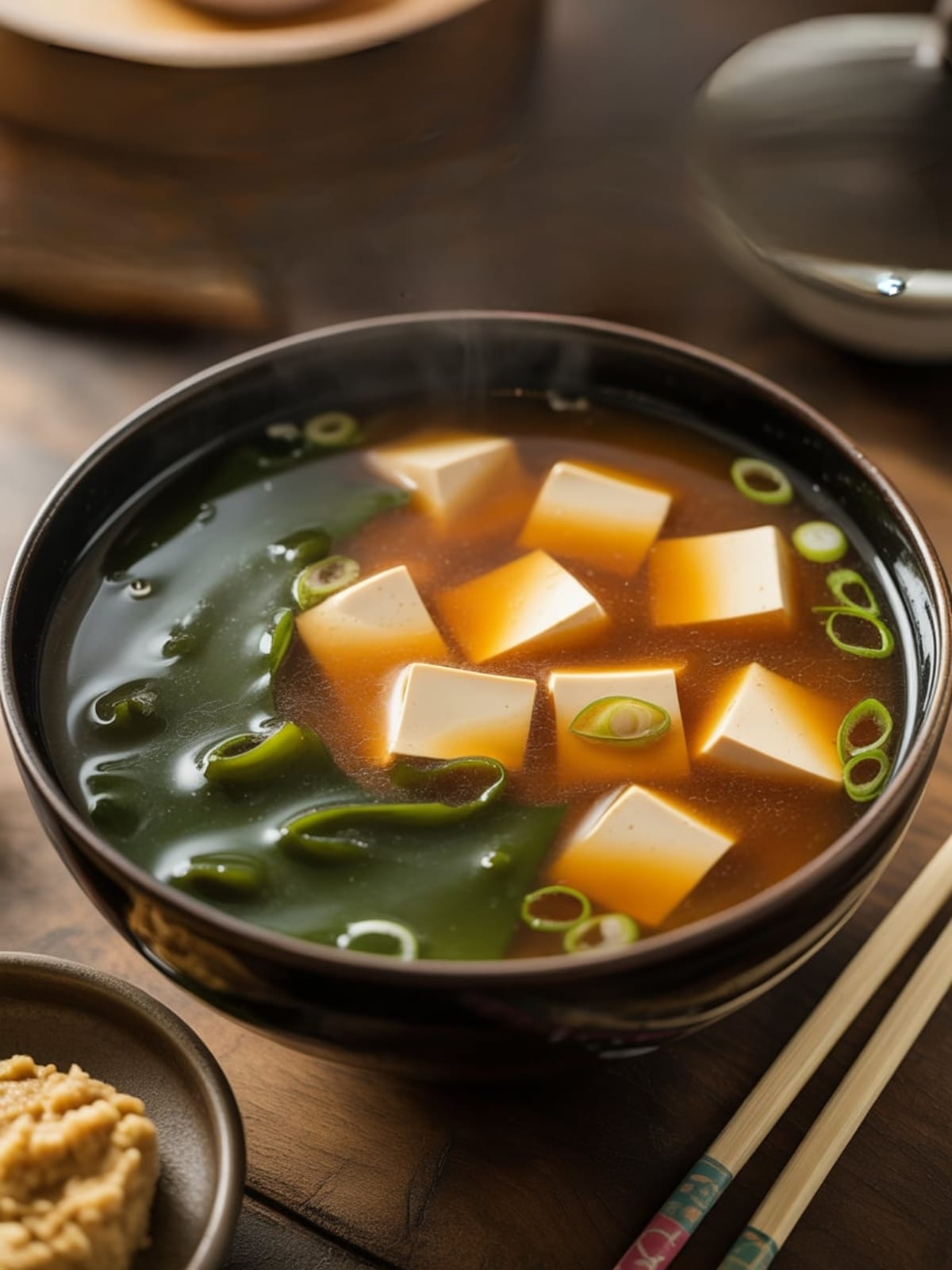Ever had one of those days when you crave something warm, comforting, and incredibly satisfying without spending hours in the kitchen? That’s exactly what a bowl of authentic Japanese miso soup offers. This humble yet profound dish has been warming Japanese households for centuries, and with just a handful of ingredients, it delivers a depth of flavor that seems almost magical in its simplicity.
While many of us have tasted miso soup at restaurants, making it at home opens up a whole new level of appreciation. The subtle umami notes, the delicate balance of flavors, and that moment when you take your first sip – it’s a small but significant culinary joy that’s surprisingly easy to create in your own kitchen.
Why This Recipe is Awesome

What makes Japanese miso soup truly special is its remarkable ability to deliver complex flavor from minimal ingredients. This isn’t just another soup – it’s a cornerstone of Japanese cuisine that perfectly balances simplicity and depth.
The beauty lies in how the fermented miso paste transforms simple dashi broth into something extraordinarily comforting. Unlike many Western soups that simmer for hours, miso soup comes together in minutes while still delivering remarkable flavor complexity. It’s incredibly versatile too – perfect as a light breakfast, a starter for dinner, or a late-night comfort food that soothes both body and soul.
What I particularly love about this recipe is how it teaches fundamental Japanese cooking techniques while being completely approachable for beginners. Master this simple soup, and you’re holding the key to understanding umami – that elusive fifth taste that elevates Japanese cuisine.
Equipment needed: Medium pot, small bowl, whisk or fork, ladle

Japanese Miso Soup
Ingredients
- 4 cups dashi stock either homemade or instant dashi powder dissolved in water
- 3-4 tablespoons miso paste white/shiro miso for milder flavor, red/aka miso for stronger flavor
- 1/2 block about 7 oz silken or soft tofu, cut into 1/2-inch cubes
- 2 tablespoons dried wakame seaweed
- 2-3 green onions thinly sliced
- Optional additions: sliced mushrooms spinach leaves, or daikon radish
Instructions
- Prepare the wakame seaweed by placing it in a small bowl with cold water for about 5 minutes until it rehydrates and expands. Once softened, drain the water and set aside.
- Heat the dashi stock in a medium pot over medium heat until it’s hot but not boiling. Keep the broth below boiling point throughout the cooking process to preserve the delicate flavors.
- Add the tofu cubes to the hot dashi and simmer gently for about 2 minutes to allow the tofu to warm through without breaking apart.
- Place the miso paste in a small bowl and add about 1/2 cup of the hot dashi from the pot. Whisk until the miso is completely dissolved with no lumps remaining.
- Turn off the heat completely before adding the miso mixture to the pot. This is crucial as boiling miso will destroy its flavor and health benefits.
- Gently stir the dissolved miso into the pot, ensuring it’s evenly distributed throughout the soup.
- Add the rehydrated wakame seaweed to the pot and stir gently to incorporate.
- Ladle the soup into individual serving bowls and garnish with freshly sliced green onions just before serving.
Notes
- The key to perfect miso soup is never boiling the miso – it kills the flavor and beneficial probiotics.
- For a heartier version, add mushrooms like shiitake or enoki when you add the tofu.
- Dashi is the foundation of good miso soup – while instant is convenient, homemade dashi (using kombu seaweed and bonito flakes) delivers superior flavor.
- This soup is best enjoyed fresh, as the flavor deteriorates when reheated, though you can store leftovers for up to 2 days in the refrigerator.
- Different varieties of miso paste will dramatically change the character of your soup – experiment with white, yellow, or red miso to find your preference.
Calories & Nutritional Info
- Calories: Approximately 70-90 calories per serving
- Protein: 5-7g per serving (primarily from tofu and miso)
- Sodium: 700-900mg (can vary based on miso paste used)
- Dietary notes: Naturally gluten-free (check miso paste labels), vegetarian when made with kombu-only dashi, good source of probiotics
- Special diets: Low-calorie, low-fat, suitable for vegetarians when using vegetable-based dashi
Common Mistakes to Avoid
- Boiling the miso: This destroys both flavor and probiotic benefits – always add miso off the heat.
- Adding too much wakame: This seaweed expands dramatically when rehydrated – start with a small amount.
- Excessive stirring: Gentle movements prevent tofu from breaking apart in the soup.
- Using only water instead of dashi: The dashi provides the foundational umami flavor – without it, miso soup tastes flat and one-dimensional.
- Adding miso directly to the pot: Always dissolve in a separate bowl first to prevent clumping and ensure even distribution.
Alternatives & Substitutions
- Dashi alternatives: Vegetable broth can work in a pinch, though the flavor profile will change substantially. For vegetarians, use kombu-only dashi.
- Tofu options: Medium or firm tofu can replace silken if you prefer more texture, though traditional versions use silken.
- No wakame? Try other seaweeds like dulse or nori, or substitute with a handful of spinach added at the end.
- Protein additions: Small pieces of cooked salmon, shredded chicken, or even a soft-boiled egg can turn this into a more substantial meal.
- Vegetable variations: Thinly sliced carrots, daikon radish, or corn kernels can add color and texture.
FAQs
Can I make miso soup ahead of time?
While best fresh, you can prepare the dashi ahead of time and refrigerate it for up to 3 days. When ready to serve, heat the dashi, add tofu, then mix in the miso paste at the last moment. Never reheat soup with miso already mixed in, as it diminishes flavor and nutritional benefits.
Which type of miso paste should beginners use?
White miso (shiro miso) is ideal for beginners due to its milder, slightly sweet flavor profile. As you become more accustomed to miso’s unique taste, you can experiment with yellow or red varieties that offer deeper, more intense flavors.
Is miso soup healthy?
Absolutely! Miso contains beneficial probiotics that support gut health, while being relatively low in calories. The soup provides protein from tofu, minerals from seaweed, and is naturally low in fat. Just be mindful of sodium content if you’re watching salt intake.
Can I freeze leftover miso soup?
I don’t recommend freezing miso soup as the texture of tofu degrades significantly, and the delicate flavor balance suffers. The soup comes together so quickly that making fresh batches makes more sense than freezing.
Why does restaurant miso soup taste different from mine?
Restaurant versions often use stronger miso varieties and house-made dashi with more concentrated flavor. They might also incorporate additional seasonings like mirin or special house blends of multiple miso pastes to create their signature taste profile.
Final Thoughts
There’s something profoundly satisfying about mastering Japanese miso soup at home – that moment when you taste your creation and realize you’ve captured that perfect balance of flavor. Don’t be surprised if this simple recipe becomes a regular part of your cooking repertoire. It’s more than just soup; it’s a small daily ritual that connects you to centuries of Japanese culinary tradition.
Give it a try, and discover how a few humble ingredients can transform into something truly extraordinary.






